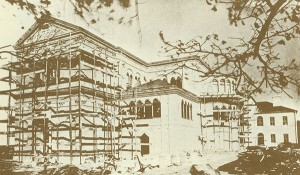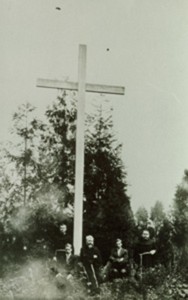History of the Franciscan Monastery
The Franciscan Monastery is the U.S. home of the Holy Land Franciscans, who have cared for the people and sacred shrines of the Holy Land for 800 years.
Here in Washington, we raise awareness of and funds for the ministry in the Holy Land, encourage vocations, welcome pilgrims to our monastery, gardens and replicas of Holy Land shrines.
Historical Resources
In partnership with The Catholic University of America, a number of historic resources from the Franciscan Monastery library are available online.
Historic Images
Searchable catalog
Early History
 The Very Reverend Charles Vassani (1831–1896) in 1880 established the Commissariat of the Holy Land in New York at 143 West 95th St.
The Very Reverend Charles Vassani (1831–1896) in 1880 established the Commissariat of the Holy Land in New York at 143 West 95th St.
From this building, he and another Holy Land Franciscan, Fr. Godfrey Schilling, began plans to build a “Holy Land in America” and a Holy Sepulchre, which they envisioned crowning a high hill on Staten Island, overlooking the entrance to New York’s harbor.
The Staten Island plan never materialized, but Fr. Vassani and Fr. Schilling did realize their dream on a wooded hilltop in the Brookland neighborhood of Washington, D.C. In 1897, Fr. Schilling purchased the McCeeney Estate in Brookland in order to found a monastery and build his church.
 Six pioneer Franciscans originally lived in the abandoned McCeeney house, which had rotten floorboards and was overrun with rats.
Six pioneer Franciscans originally lived in the abandoned McCeeney house, which had rotten floorboards and was overrun with rats.
Fr. Schilling soon engaged the well-known architect, Aristide Leonori (1856-1928), who would later design the Cathedral Basilica in St. Louis, to design and supervise the construction of the church and monastery. Leonori visited the Holy Land and took accurate measurements and photographs of the holy sites that were to be reproduced.
 A huge wooden cross was erected on the hilltop, which is today the site of the Friars’ Cemetery, behind the monastery. In February 1898, ground was broken for a new building, and the cornerstone was laid on the March 19 Feast of St. Joseph.
A huge wooden cross was erected on the hilltop, which is today the site of the Friars’ Cemetery, behind the monastery. In February 1898, ground was broken for a new building, and the cornerstone was laid on the March 19 Feast of St. Joseph.
To fund the construction, Fr. Godfrey sold paper bricks, called “building bricks,” which were 2.5 x .5 inches and contained a medal of St. Anthony of Padua. The building bricks were sold for 10 cents each. When the church was completed, a year later, it was nearly free of debt.

